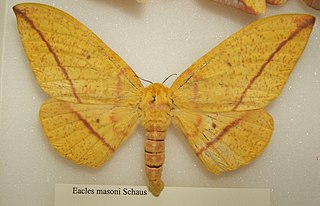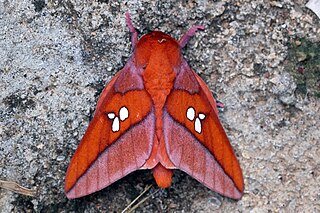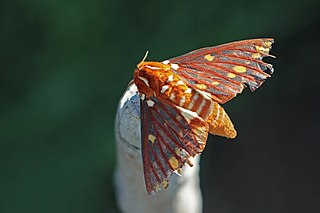
Saturniidae, commonly known as saturniids, is a family of Lepidoptera with an estimated 2,300 described species. The family contains some of the largest species of moths in the world. Notable members include the emperor moths, royal moths, and giant silk moths.

Arsenura armida, the giant silk moth, is a moth of the family Saturniidae. It is found mainly in South and Central America, from Mexico to Bolivia, and Ecuador to south-eastern Brazil. It was first described by Pieter Cramer in 1779.

Eacles masoni is a moth of the family Saturniidae. It is found from Mexico, south to Ecuador and Colombia.

Titaea timur is a moth of the family Saturniidae. It is only known from Misahualli in Ecuador.

Automeris larra is a moth of the family Saturniidae. It is found in South America, including Brazil, French Guiana, Venezuela, Colombia, Peru, Bolivia and Ecuador.

Automeris metzli is a moth of the family Saturniidae. It is found from Mexico to Venezuela, Colombia and Ecuador and can also be found in Trinidad

Rothschildia erycina, or Rothschild's silk moth, is a moth of the family Saturniidae first described by George Shaw in 1796. It is found from Mexico to Brazil and Paraguay. The habitat is tropical rainforest and wet savannah. It is found on altitudes of up to 1,200 meters above sea level.

Automeris is a genus of moths in the family Saturniidae and the subfamily Hemileucinae. As of 1996 there were 124 species, and more have since been described. These moths are generally characterized by the eyelike patches on the hindwings and the leaflike pattern on the forewings, an example of crypsis. The genus was first described by Jacob Hübner in 1819 and it is distributed in the Neotropical realm.

Syssphinx is a genus of moths of the family Saturniidae. The genus was erected by Jacob Hübner in 1819.

Adelowalkeria is a genus of moths in the family Saturniidae first described by Travassos in 1941.

Citheronia is a genus of moths in the family Saturniidae. The genus was erected by Jacob Hübner in 1819.
Citioica is a genus of moths in the family Saturniidae.

Rhescyntis is a genus of moths in the family Saturniidae first described by Jacob Hübner in 1819.

Rothschildia orizaba, the Orizaba silkmoth, is a moth in the family Saturniidae. The species was first described by John O. Westwood in 1854. It is found in Mexico, Central and South America.

Automeris belti is a moth of the family Saturniidae first described by Herbert Druce in 1886. It is found from Mexico to Colombia and Ecuador.

Titaea tamerlan is a moth of the family Saturniidae found in Central and South America.

Caio championi is a large moth of the family Saturniidae first described by Druce in 1886. It is found from Mexico to Guatemala, south to western Ecuador and northern Venezuela.

Eacles ormondei is a moth of the family Saturniidae. It is found in tropical America.
Eacles callopteris is a moth in the family Saturniidae. It is found in Bolivia, Ecuador and Peru. It is very similar in appearance to Eacles acuta.

















